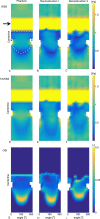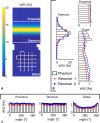Influence of the Accuracy of Angiography-Based Reconstructions on Velocity and Wall Shear Stress Computations in Coronary Bifurcations: A Phantom Study
- PMID: 26690897
- PMCID: PMC4686962
- DOI: 10.1371/journal.pone.0145114
Influence of the Accuracy of Angiography-Based Reconstructions on Velocity and Wall Shear Stress Computations in Coronary Bifurcations: A Phantom Study
Abstract
Introduction: Wall shear stress (WSS) plays a key role in the onset and progression of atherosclerosis in human coronary arteries. Especially sites with low and oscillating WSS near bifurcations have a higher propensity to develop atherosclerosis. WSS computations in coronary bifurcations can be performed in angiography-based 3D reconstructions. It is essential to evaluate how reconstruction errors influence WSS computations in mildly-diseased coronary bifurcations. In mildly-diseased lesions WSS could potentially provide more insight in plaque progression.
Materials methods: Four Plexiglas phantom models of coronary bifurcations were imaged with bi-plane angiography. The lumens were segmented by two clinically experienced readers. Based on the segmentations 3D models were generated. This resulted in three models per phantom: one gold-standard from the phantom model itself, and one from each reader. Steady-state and transient simulations were performed with computational fluid dynamics to compute the WSS. A similarity index and a noninferiority test were used to compare the WSS in the phantoms and their reconstructions. The margin for this test was based on the resolution constraints of angiography.
Results: The reconstruction errors were similar to previously reported data; in seven out of eight reconstructions less than 0.10 mm. WSS in the regions proximal and far distal of the stenosis showed a good agreement. However, the low WSS areas directly distal of the stenosis showed some disagreement between the phantoms and the readers. This was due to small deviations in the reconstruction of the stenosis that caused differences in the resulting jet, and consequently the size and location of the low WSS area.
Discussion: This study showed that WSS can accurately be computed within angiography-based 3D reconstructions of coronary arteries with early stage atherosclerosis. Qualitatively, there was a good agreement between the phantoms and the readers. Quantitatively, the low WSS regions directly distal to the stenosis were sensitive to small reconstruction errors.
Conflict of interest statement
Figures







Similar articles
-
The impact of scaled boundary conditions on wall shear stress computations in atherosclerotic human coronary bifurcations.Am J Physiol Heart Circ Physiol. 2016 May 15;310(10):H1304-12. doi: 10.1152/ajpheart.00896.2015. Epub 2016 Mar 4. Am J Physiol Heart Circ Physiol. 2016. PMID: 26945083
-
Coronary arteries hemodynamics: effect of arterial geometry on hemodynamic parameters causing atherosclerosis.Med Biol Eng Comput. 2020 Aug;58(8):1831-1843. doi: 10.1007/s11517-020-02185-x. Epub 2020 Jun 9. Med Biol Eng Comput. 2020. PMID: 32519006
-
In-vivo coronary flow profiling based on biplane angiograms: influence of geometric simplifications on the three-dimensional reconstruction and wall shear stress calculation.Biomed Eng Online. 2006 Jun 14;5:39. doi: 10.1186/1475-925X-5-39. Biomed Eng Online. 2006. PMID: 16774680 Free PMC article.
-
A Pseudo-Spectral Method for Wall Shear Stress Estimation from Doppler Ultrasound Imaging in Coronary Arteries.Cardiovasc Eng Technol. 2024 Dec;15(6):647-666. doi: 10.1007/s13239-024-00741-2. Epub 2024 Aug 5. Cardiovasc Eng Technol. 2024. PMID: 39103664 Review.
-
Computational fluid dynamics in coronary artery disease.Comput Med Imaging Graph. 2014 Dec;38(8):651-63. doi: 10.1016/j.compmedimag.2014.09.002. Epub 2014 Sep 16. Comput Med Imaging Graph. 2014. PMID: 25262321 Review.
Cited by
-
Multidirectional wall shear stress promotes advanced coronary plaque development: comparing five shear stress metrics.Cardiovasc Res. 2020 May 1;116(6):1136-1146. doi: 10.1093/cvr/cvz212. Cardiovasc Res. 2020. PMID: 31504238 Free PMC article.
-
Blood Flow Energy Identifies Coronary Lesions Culprit of Future Myocardial Infarction.Ann Biomed Eng. 2024 Feb;52(2):226-238. doi: 10.1007/s10439-023-03362-3. Epub 2023 Sep 21. Ann Biomed Eng. 2024. PMID: 37733110 Free PMC article.
-
Association Between Automated 3D Measurement of Coronary Luminal Narrowing and Risk of Future Myocardial Infarction.J Cardiovasc Transl Res. 2024 Aug;17(4):893-900. doi: 10.1007/s12265-024-10500-2. Epub 2024 Mar 1. J Cardiovasc Transl Res. 2024. PMID: 38427153 Free PMC article.
-
Wall shear stress and its role in atherosclerosis.Front Cardiovasc Med. 2023 Apr 3;10:1083547. doi: 10.3389/fcvm.2023.1083547. eCollection 2023. Front Cardiovasc Med. 2023. PMID: 37077735 Free PMC article. Review.
-
Integrating hemodynamic analysis with traditional imaging in intracranial atherosclerotic stenosis: current status and future perspectives.Front Neurol. 2025 Jul 18;16:1589162. doi: 10.3389/fneur.2025.1589162. eCollection 2025. Front Neurol. 2025. PMID: 40757026 Free PMC article. Review.
References
-
- Virmani R, Kolodgie FD, Burke AP, Farb A, Stephen M, Schwartz SM. Lessons From Sudden Coronary Death : A Comprehensive Morphological Classification Scheme for Atherosclerotic Lesions. Arterioscler Thromb Vasc Biol. 2000;20: 1262–1275. - PubMed
-
- Stone PH, Saito S, Takahashi S, Makita Y, Nakamura S, Kawasaki T, et al. Prediction of progression of coronary artery disease and clinical outcomes using vascular profiling of endothelial shear stress and arterial plaque characteristics: the PREDICTION Study. Circulation. 2012;126: 172–81. 10.1161/CIRCULATIONAHA.112.096438 - DOI - PubMed
Publication types
MeSH terms
LinkOut - more resources
Full Text Sources
Other Literature Sources
Medical
Research Materials

